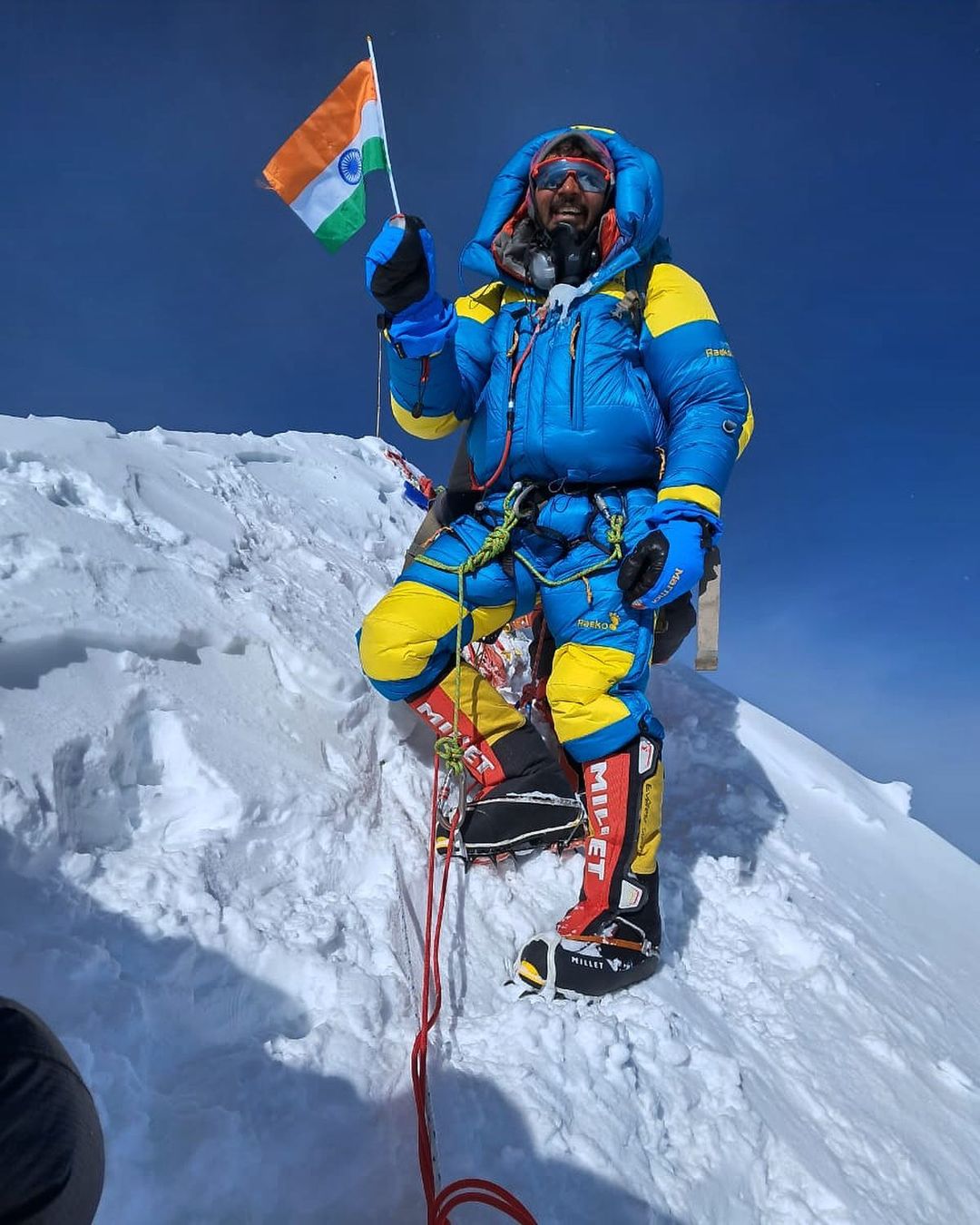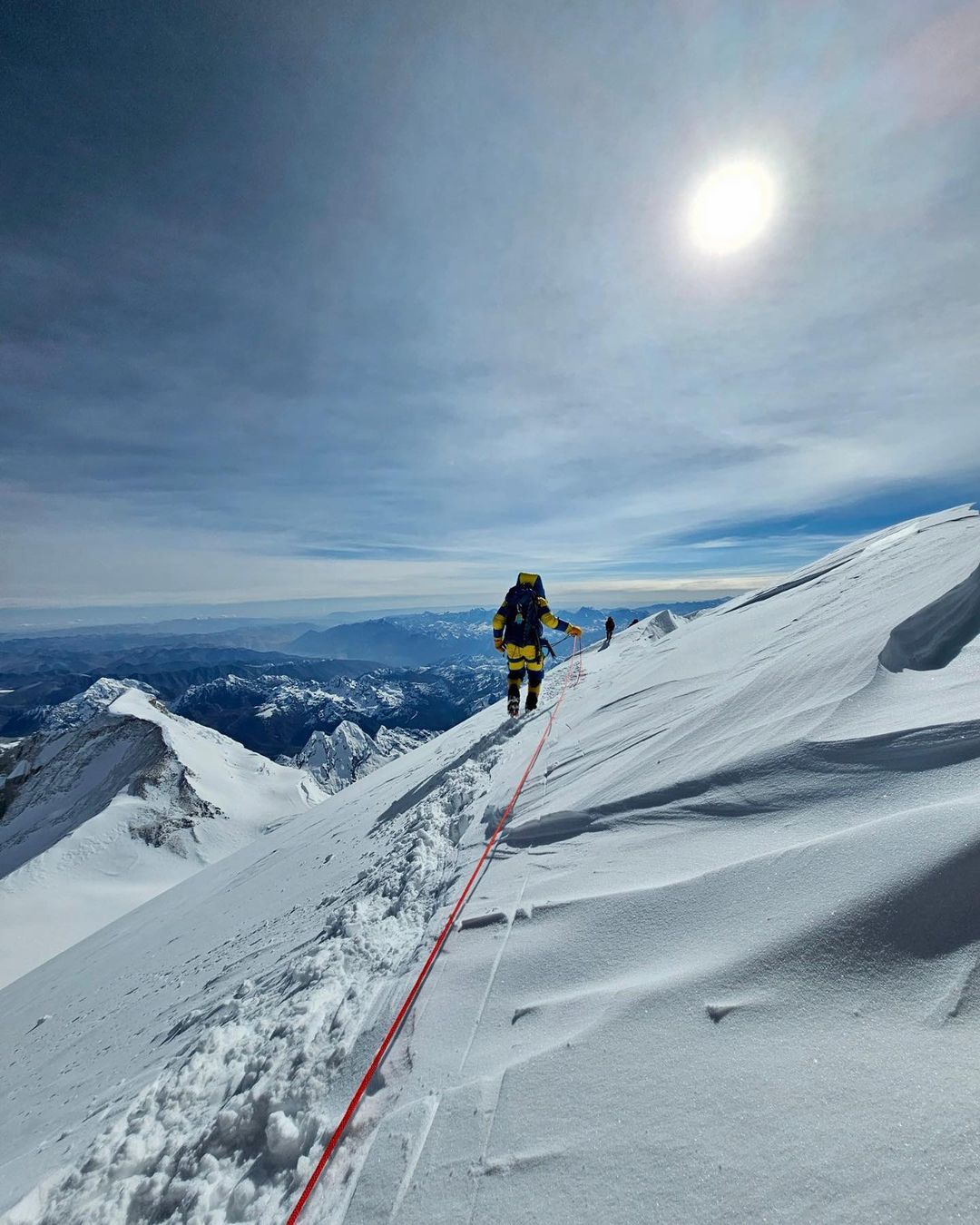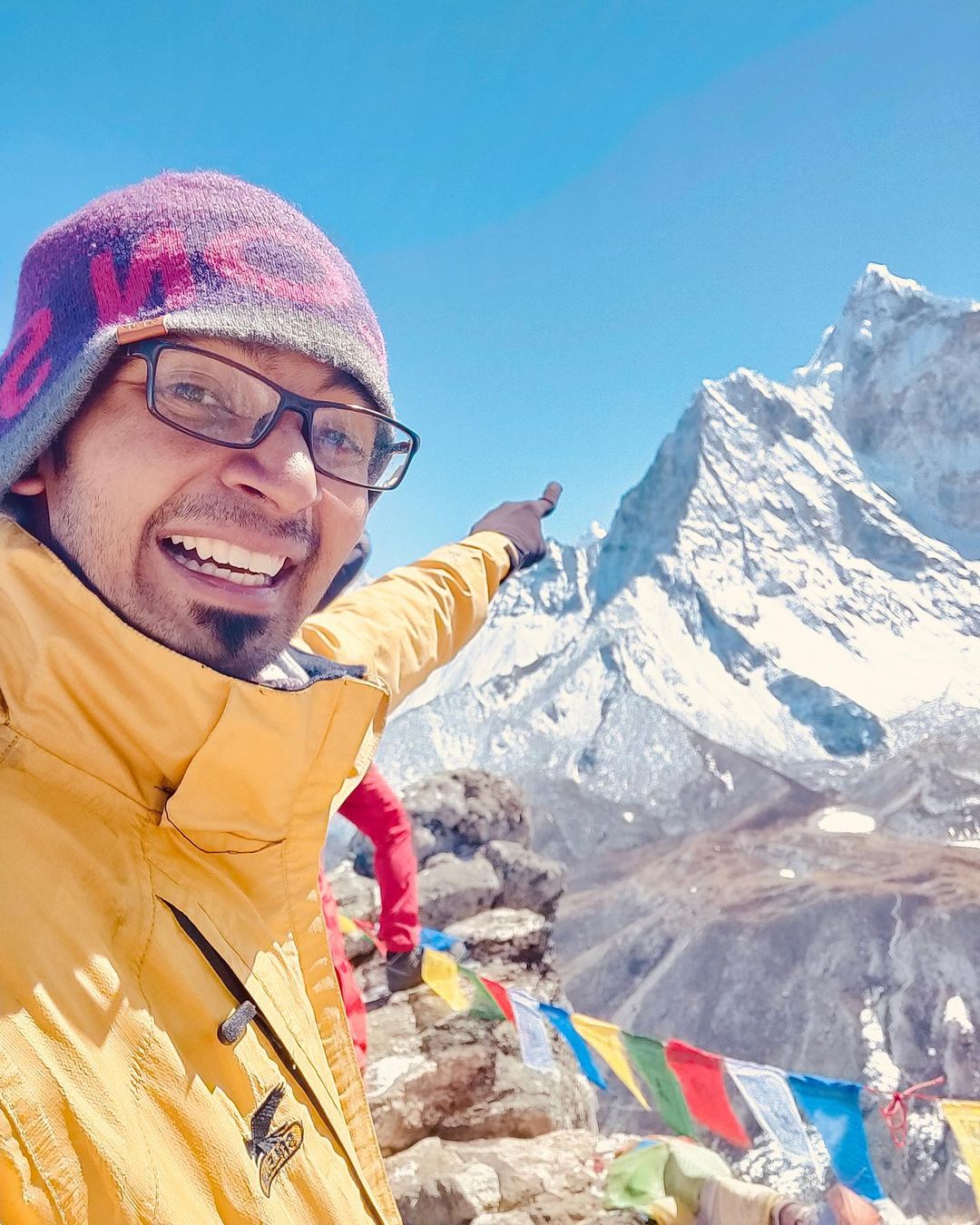
Akhil: I was speaking to Sehgal Sahab from Boots & Crampons on a webinar and I mentioned that I find trekkers and mountaineers to be the most interesting people on the planet because they manage to follow their passion. In reality, we are in the mountains for a few weeks and think about the mountains for the remainder of the year.
Keval: It's the other way around for me. I am out in the mountains for 300 days and hardly get any time to think about them. Whenever I feel, I just go.
Akhil: You've done a good job mixing your passion and profession. What were you doing before?
Keval: I was doing automobile engineering, I left it in my final year. I knew if I got the degree, matlab kahi na kahi job toh karna hi padega. The only thing I kept thinking at that time was that I wanted to give my 100% to the mountains and focus on one thing. I did not think of having a backup plan and jumped. I've been lucky enough to reach the summit of an 8000'er peak every year since 2017, except for one year of Covid. That's a blessing.
Akhil: Sometimes, not having a Plan B is the best plan. What triggered this passion in you.
Keval: I started hiking when I was in 7th grade. Went to Chandrakhani Pass, then did many one day hikes. My mind was already inclined towards adventure. I was not enjoying the process when I was doing engineering. I worked as an intern at Vardenchi Motorcyles but still I could not get the mental peace and happiness. I felt stuck. Even when I would be studying or working on my practicals, I would be planning my next trip to the mountains.
Then I thought to myself, itni planning karni hi hai toh let's make this my profession.
Akhil: How did you meet your wife Krupa?
Keval: I was working for a trek operator and had just finished Beas Kund trek. I was back and Patalsu Peak was next. My co-trek leader didn't show up due to health reasons and Krupa came along. It was a coincidence that we met. Destiny made us meet in the mountains.
There's so much planning that goes into a trek. What time to leave, take care of each participant, check on who's not feeling well. While trekking I came to know that she is a very good person. She was extremely concerned about the participants and I thought to myself that this is an important quality in a partner. We did 14-15 Himalayan treks together and came closer. After 7 years, we got married last year.

Akhil: You've climbed seven 8000m peaks in 6 years. Your physical, mental state and diet has to be on point. Let's start with your diet.
Keval: I'm a pure vegetarian, I don't even consume eggs. I was born in a Kutchi Jain family so from a religious point of view also I follow vegetarianism.
Akhil: What does your diet look like 4 months prior to going on a high altitude expedition?
Keval: I follow the same diet throughout the year because I feel I should be prepared for the mountains anytime. If I find a 10 day window, I will plan to go to Ladakh and climb a 6000 peak. It happens very spontaneously. I also follow alpinism, which makes it even more easier to plan logistically. I carry everything on my own.
I eat a protein and carbs balanced diet. Paneer, tofu, sprouts, soybean, banana, pulses and dried fruits. I eat 5 times a day.
Akhil: Do you meditate and how has it helped you?
Keval: Everyone has a different definition for meditation. For me it means connecting my mind and my soul. If they are connected I can start solving problems. There's so many things that go into an expedition - finding sponsors, right season, weather, training, aging body - the mind is constantly working to find solutions to these problems. It doesn't get any rest. Even before going to bed I'm searching if there is a new route to a peak, searching for lighter, better gear.
When I meditate, I focus on not thinking. I close my eyes, sit straight and focus on giving my mind and body the rest. I imagine deleting unnecessary thoughts and that way helping mind and body to become more powerful. This is the concept of Ekagrata.
This has helped me to not lose my cool easily. When climbing Everest, we went for an acclimatization walk from camp 2 to camp 3. I was filming using my GoPro when I captured an avalanche on camera. I was too busy working the settings to realise I was really close to it. I ran to my left and fell in a hidden crevice. I usually carry an ice axe with me all the time. I planted it, turned over and got myself out of it within a fraction of seconds. This wouldn't happen if my mind wasn't alert. Meditation helps.
I have seen so many people die in the mountains. It's not easy to keep going. Meditation has helped me control my emotions. Only a strong mind and will can help you to keep going.
Akhil: This makes a lot of sense. I was speaking with Aanchal Aneja who mentioned that she find martial arts to be a meditative practice. Deeya Bajaj another Everest Club members finds swimming to be her way of meditation. I think if you do something regularly it gives you the opportunity to close each though like a window in your browser.
Akhil: How does a mountaineer train physically?
Keval: Mountaineering is a very steady sport. You should not rush too early and end up not having any fuel left over later on. It's more a marathon than a sprint.
You have to train the entire body when you are preparing for the mountains. A heavy backpack is weight on my shoulder, lower and upper back. The legs muscles are pushing me up, biceps, forearms, triceps and chest are pulling me up on an icy climb, you need finger and grip strength for rock climbing. My training program covers the entire body.
Most importantly, your need to train vertically. You're going against gravity in the mountains, you need to train your muscle memory vertically. The best full body vertical workout is climbing stairs. Add a weighted backpack and gives you the same feeling of climbing a mountain. Actually, the best training for mountains is to train in the mountains, stairs is second best. I live close to small hills and do a lot of trail running on uneven surfaces. I live in Mumbai and do rock climbing in Sahyadris.
I do planks, leg raises, crunches to strengthen my core.
Akhil: What's the difference between training for a 6000m vs 8000m peak?
Keval: When I decided to pursue mountaineering I decided to make it my lifestyle. Instead of training for an individual peak, I only train for the mountain. You are preparing for the worst conditions because on a bad day any mountain can become challenging. My training is equally intense for a 6000m peak and and a 8000m peak.

Akhil: How can one train for ladder crossings over a crevice?
Keval: So I was on Everest in 2019 and again this year in 2023. This year, when we went up there were two ladders but while returning there were three. Snow on which the ladder was resting had partially collapsed, the ropes were weak and the ladders were unstable. Three Sherpas had earlier died on the same spot. Their bodies to be never found again.
I have found slack-lining to be a useful exercise to work on my balance. In the mountains, you wake up in the middle of the night, hurry up to pack and head out for summit. Your backpack is not evenly balanced. Your body has to do the work of balancing.
Slack lining has helped me strengthen my core and find the center of my body's gravity. When you practice on a few inches of space and then get more in the mountains on a ladder it helps.
Akhil: I've asked that question multiple times, this is the best answer so far. Akhil: Let's go back to 2018 to my favourite mountain Stok Kangri. I could not believe the story when I read it, I want to hear it from you. Tell us what happened there?
Keval: My friend and I wanted to climb Stok in the winters, alpine style. We took a local guy along and the remote valley where we were climbing was around -40 degrees. We faced two days of heavy snowfall and thought we might not get a chance to reach the top. When snow stopped we climbed half way, tried opening the trail in three and a half feet snow. The next day it took us sixteen hours to reach the summit. While descending my climbing partner twisted her ankle and we had to assist her. I was walking ahead and digging snow with my hands. I lost the tip of my thumb from frostbite.
Akhil: WAIT, WAIT, WAIT! You said that in a single breath like you lost a pair of gloves and not the tip of a body part.
Keval: Well, when we got back to the base camp I had pain in my finger so I immediately dipped it in hot water. The next day it took us 7 hours to reach Leh. I went to the hospital but they did not have any medical facilities to deal with frostbites.
I was told to leave Leh immediately due to the cold weather and lack of frequent flights back home. I flew to Delhi and went to AIMS hospital, even they did not have much idea how to cure a frostbite. Then I flew to Mumbai and started researching on my own. After almost 15 days I found out about Hyperbaric Oxygen Therapy (HBOT). The only issue is that you are supposed to use it within 24-36 hours of getting a frostbite.
Last year while climbing Kanchenjunga I had frostbite in my right toe. I turned around halfway up the summit but it took me almost a day to get back to base camp. Kanchenjunga is massive. I took a chopper next day to Kathmandu and immediately flew back to Mumbai to start HBOT. I was able to save half of my right toe.
On further research I came across a medicine called Trental 400 which immediately helps with vesicular injuries by increasing the blood flow to arms and legs. This atleast buys you more time in the mountains to return to civilisation and start HBOT.
Fortunately, there's a HBOT center in Nepal now.

Akhil: You've climbed 7 out of the 9 highest 8000'ers that Indians can attempt. What's the plan for Shishapangma and Kanchenjunga?
Keval: Climbing seven 8000'ers has cost a lot! Some from sponsors but mostly from my savings. I have started pitching to sponsors for climbing Kanchenjunga in 2024. The Tibetan government (China) has increased the price of climbing Shishapangma that it is more costlier than climbing Mt. Everest. It costs almost 28-30L now.
Akhil: What's the roadblock for sponsors to get more involved in mountaineering?
Keval: It's really important to make the right connection. How you approach, who you approach through, who you are able to reach - all these things matter. It was confusing for me in the beginning which department to approach in a corporate.
Companies have begun to understand the power of content a mountaineer can deliver. NIMSDAI proved on Netflix that nothing is impossible. He opened the doors for future mountaineers to able to reach the masses. Before, the general public was not aware of the 14 peaks.
I climbed Cho Oyu and Manaslu without a sherpa or supplemental oxygen. No one talked about it. When I did Everest and Lhotse, people started talking because Everest was involved.
Sponsors have begun to get more involved. They are checking out social media profiles and opening discussions.
Akhil: You're very young to have a biography written after. If one was written what would the title be?
Keval: It will be called "Beyond The Limits". This word 'beyond' has changed my life. My adventure company is called "Beyond Altitudes" because it was my curiosity that led me to start this profession. I did 6000m peaks, then 7000m then 8000m peaks and I am still pushing my limits.
Akhil: Any last parting thoughts, stories, advice.
Keval: There were this group of eight year old kids on a trek that kept throwing trash everywhere in-spite of being asked repeatedly not to. They just won't listen. A few hours later, I asked them to stand near the garbage and started taking their pictures.
The kids said 'aray sir yaha par mat kheecho, mountains ke saath kheecho, yaha kachara hai.' I replied 'oh I thought you like kachara, tabhi toh tum log usay har jagah faila rahe ho na?'
Then they realised and apologised. It's one thing to talk about global warming but we need to find the relevant triggers and put our points across accordingly.
Earlier, we would pile up in a government bus to go on a trek. Now there's private vehicles emitting so much carbon to take trekkers. There's so much that goes into the logistics of a trek. Still, we complain and compare - 'oh that trekking company gives chairs and tables, you don't'. Whatever happened to sitting by the riverside on rocks?
Competition has led to providing more facilities. Bigger tents, fixed tents. We have destroyed complete grasslands because tents are pitched throughout the season.
When we as trekkers control our 'asks' it becomes easier.
